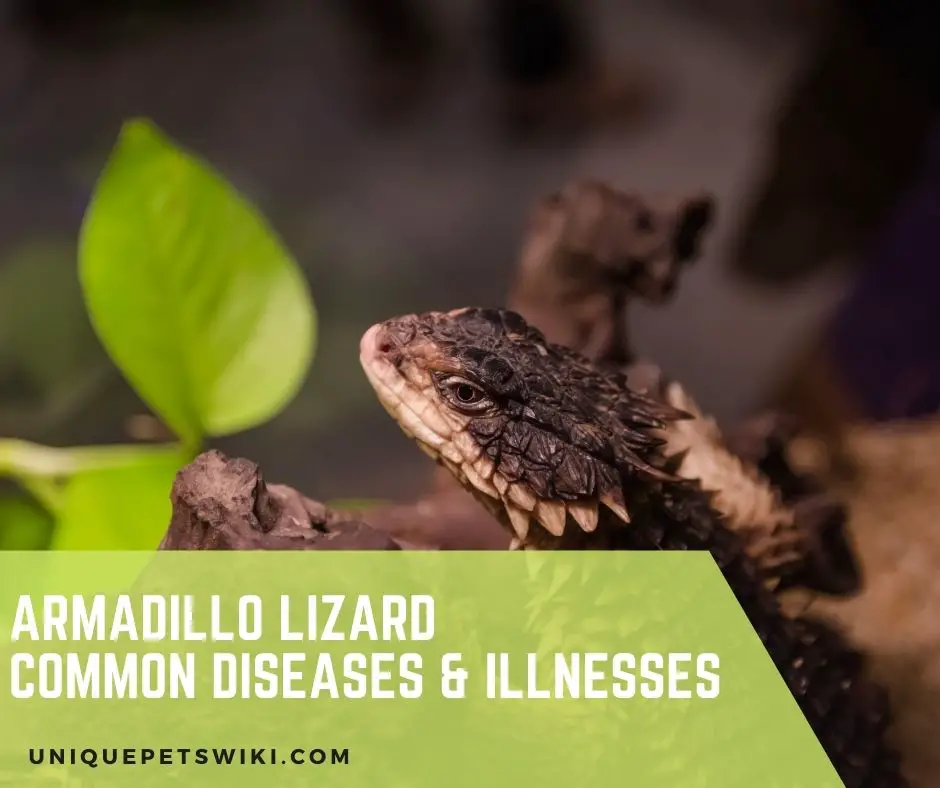Common Armadillo Lizard Diseases And Illnesses: What are they? Will my armadillo lizard ever gets so sick to point of death? How can I tell my lizard is sick? What should I do because I’m worried? Relax! you are at the right place of getting these problems solved.
Armadillo Lizards Are Tiny And Unique Reptile Species That Can Be Kept As pets Even For Beginner Hobbyists. Their Main Defense Mechanism Is To Curl Up And Bite Their Tails Just Like The Armadillo. They Also Have Fascinating Thorny Coats Of Armor And They Are The Closest Thing To A Dragon That You Can Keep.
Armadillo lizards are hardy reptile species, you need to keep their health at an optimal level by providing them with optimal care at all times. As a responsible pet owner, it is important to know about signs of sickness in armadillo lizards before you even decide to bring one home.
In this article, you will get more insight into armadillo lizard common diseases and illnesses, symptoms of sick lizards, and ways to prevent and treat them.
This article has been reviewed by Dr. Gospel. Read more about our knowledge control process here.
Contents
Signs Of A Healthy Armadillo Lizard
You can easily maintain your armadillo lizard health if you know how a healthy species behaves. Some of the signs of a healthy armadillo lizard are stated below.
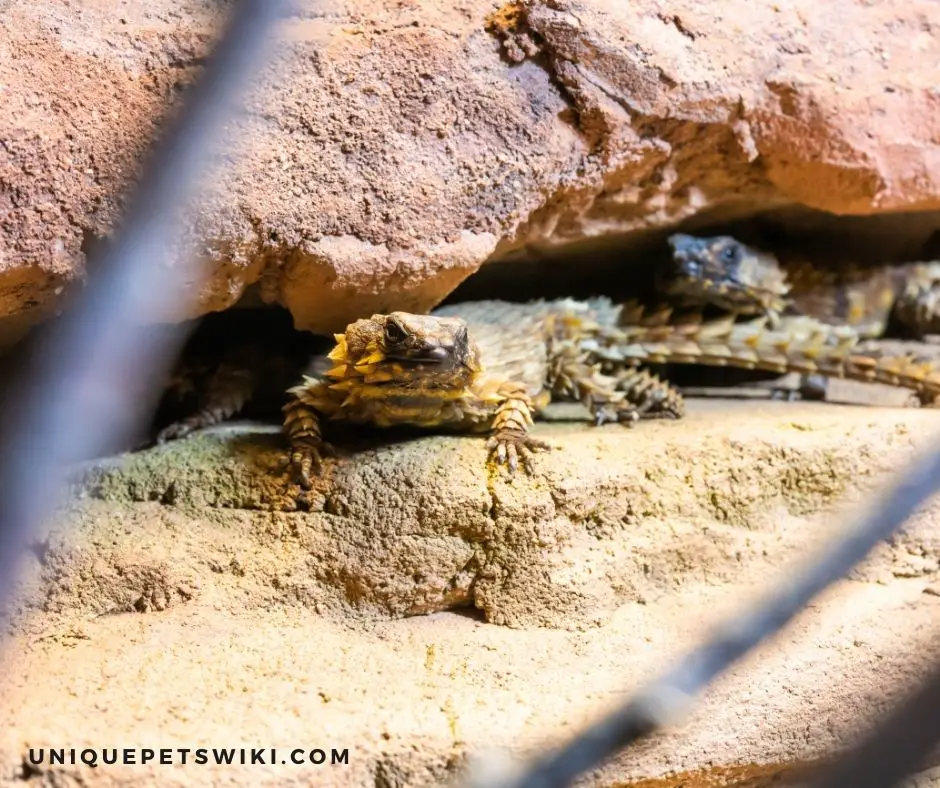
Size & Weight
A healthy hatchling and juvenile armadillo lizards usually grow quickly. A healthy baby armadillo lizard is usually about two inches in length at birth. However, a juvenile armadillo lizard grows between 2.3 and 3.7 inches. Furthermore, adult armadillo lizards usually grow to just over four inches in length.
Some of the things that can affect armadillo lizard size and weight are stress, bullying, internal parasites, and so on. This shows once your lizard is underweight, it is suffering from one form of disease or another.
Productivity
Armadillo lizards are ovoviviparous reptiles which means they give birth to one or two young ones alive. Furthermore, they usually put a gap between their reproductive years to care for their baby. However, if your armadillo lizard is not reproducing then it may be suffering from a disease.
Eating Frequently
Although armadillo lizards do not require much attention when compared to other pet reptiles out there. A healthy armadillo lizard will eat until they are bellyful once a day. Once you notice that your armadillo lizard stops eating, then it may be suffering from a disease.
Poop
A healthy armadillo lizard poop usually comprises three components, namely poop, urine, and urates. The urates are the solid form of urine and it is secreted to help the lizard minimize water loss. Your armadillo lizards may be suffering from a disease if it has runny poop.
Shedding
One of the ways that you can determine if an armadillo lizard is sick is by shedding. A healthy armadillo lizard doesn’t usually have any issue with shedding. However, unhealthy armadillo lizards can have an issue with shedding and you may have to help it.
Some of the other signs of a healthy armadillo lizard are:
- Basking frequently.
- Occasionally hiding under rocks.
Signs Of A Sick Armadillo Lizard
Here are some signs that your armadillo lizard may start displaying when suffering from a disease or illness.
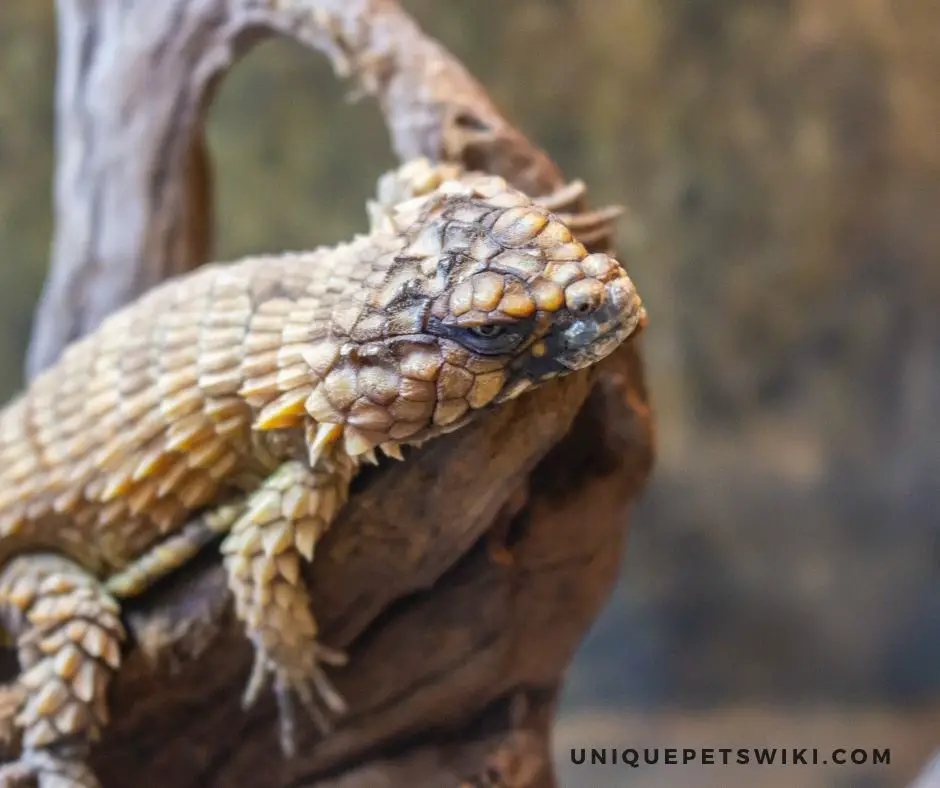
Lack Of Appetite
Armadillo lizards are omnivorous animals and love eating. One of the first signs that your armadillo lizard will give you when suffering from illness is that it will stop eating. Even if your armadillo lizard does not eat only once, you should not ignore this sign.
This is why it is best to monitor your lizard closely and once you notice any change, you can take them to the vet.
Fewer Droppings
Droppings go hand in hand with the appetite. This is because when the armadillo lizard is not pooping or pooping less, then it means that it is not eating food. Therefore, once your armadillo lizard is not pooping, you should take note of its appetite.
Apart from a decrease in appetite, another thing that can lead to a reduction in stool production is constipation.
Lethargy
Healthy armadillo lizards are usually bright-eyed while moving around their tanks or basking in the sunlight. Furthermore, they will also respond to what they see and looks alert. However, sick armadillo lizards are usually too weak to move and they can stay in one place for hours.
Once you notice that your armadillo lizards display this kind of behavior, you should have it checked out immediately.
Some of the other signs of sickness in armadillo lizards are
- Excreting pus around the mouth area.
- Swelling in the rear legs.
- Weight loss
- Can’t climb vertical surfaces
- Vomiting
- Eye discharge and swelling
- Soft bones, tail or spine kinks
- Retained shed
- Floppy tail
- Prolapsed hemipenis
The 8 Most Common Armadillo Lizard Diseases And Illnesses
A sick lizard cannot do much. To move a limb or even eat usually becomes a problem. This is as well the case with sick armadillo lizards. Common diseases and illnesses you’ll likely notice in your pet armadillo include:
- Mouth Infections
- Metabolic Bone Disease
- Respiratory infection
- Retained Shed
- Prolapse Of Hemipenis In Male Armadillo Lizards
These diseases will always manifest itself with symptoms such as loss of appetite, weight loss, weak bones and lethargy.
Here are some common diseases and illnesses that can affect your armadillo lizards in detail.
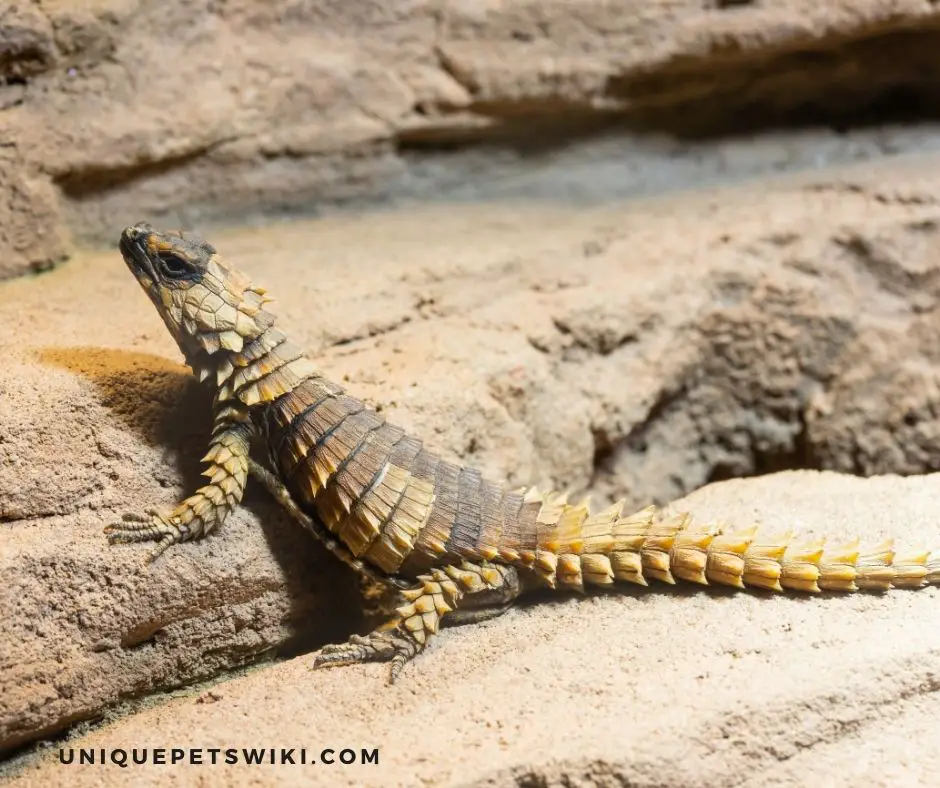
Mouth Infections
This is a swelling that causes redness of the mouth of your armadillo lizards because of insufficient heat in their enclosure. However, this can be more serious than you imagined if you did not treat it immediately.
You can prevent mouth infections by placing a thermometer in their enclosure to help monitor the temperatures, especially in winters. You can treat mouth infections in armadillo lizards by taking your lizard to the vet for antibiotics. Your lizard will recover from this infection quickly after taking antibiotics.
Metabolic Bone Disease
Armadillo lizards can develop Vitamin-D deficiencies, reduced diet-intake, and stressed behaviors if you don’t provide them with UVB lighting. This is because they need UVB light to absorb calcium. Furthermore, the absence of calcium can then lead to the development of Metabolic Bone Disease (MBD).
Metabolic bone disease in the armadillo lizard can lead to deformation of bones and can lead to disability if not treated. However, you can treat this by providing them with UVB lighting and supplementing their food with calcium.
Respiratory Issues
Armadillo lizards need a warm temperature around 110-115 degrees Fahrenheit for a normal body function. However, low temperature or increased humidity levels can lead to respiratory issues.
Some of the signs of a respiratory issue in armadillo lizards are mucus emission, gasping, and breathing heavily. Once you notice your lizard is suffering from a respiratory issue, you can take them to the vet for the best way to treat it.
Retained Shed
There are situations where your armadillo lizard will have a stuck shed all over their body, especially the tail and toe. Stuck shed usually occurs in armadillo lizards because of dehydration or low humidity.
However, stuck sheds can constrict blood flow which can cause loss of their tail tips, toes, or even the foot. The best thing is that you can help your lizard out once this happens. All you need is to give them a lukewarm bath and once their skin dries out, you can then help to peel it off.
However, you will need to ensure the water is not too hot or warm because your lizard can get heatstroke if exposed to high temperatures.
You can also prevent this by designating a damp area in their enclosure where they can go during the shedding period. You can also place a water bowl in their tank to provide them with water whenever they need it.
Prolapse Of Hemipenis In Male Armadillo Lizards
Male armadillo lizards use their hemipenis for mating. After mating, the hemipenis will then retract back within an hour. However, there are situations where it can take some hours and even a day without retracting.
You will need to give your lizard a sugar bath if the hemipenis does not retract after 5-6 hours. You can do this by mixing some water with sugar in a container and then place your armadillo lizard there for about 10 minutes.
You can repeat this process a few times before it retracts. However, if this does not work, you may need to take your lizard to the vet as soon as possible to prevent necrosis of the hemipenis. Your vet will help to push the hemipenis back in or will cut off the hemipenis if necrosis occurs.
Note: armadillo lizards have two hemipenes and will be able to breed if a vet cuts off one.
Armadillo Lizard Pooping Problems
One of the most important body functions of armadillo lizards is pooping. Furthermore, your armadillo lizard is healthy if it is pooping. Some of the reasons why your armadillo lizards are not pooping are:
- Your lizard is not eating
- Your armadillo lizard is impacted or constipated
- There is a low temperature in their enclosure
- Your armadillo lizard is dehydrated
- Your armadillo lizard is sick
Do Armadillo Lizards Die Of Old Age?
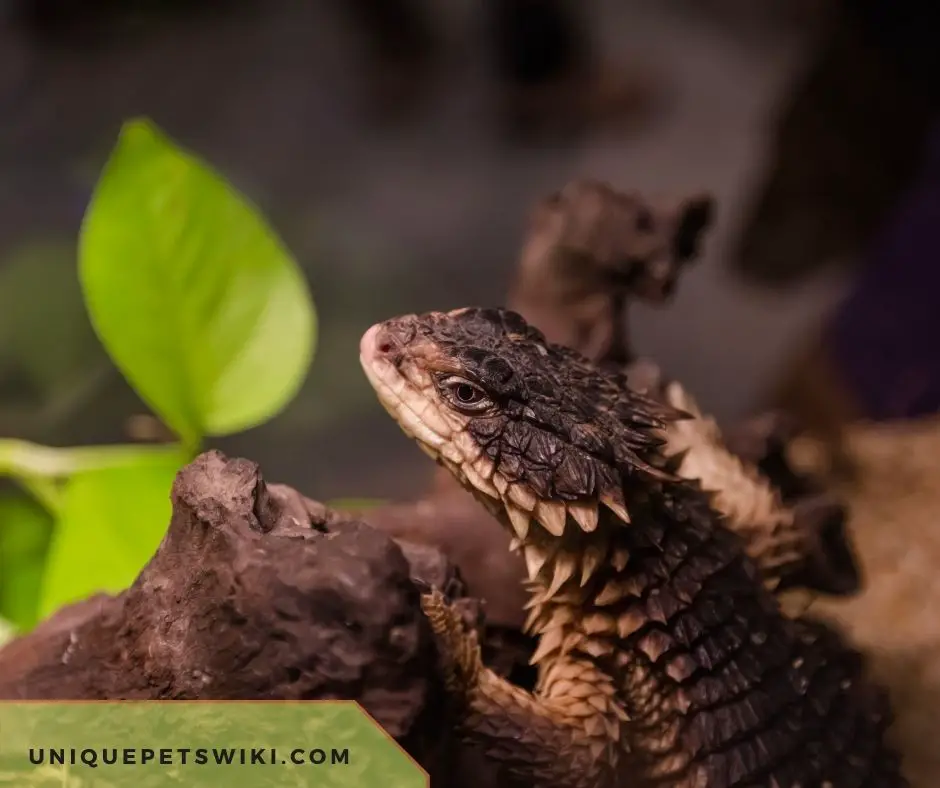
Yes, armadillo lizards can die of old age. However, they are long-lived reptile species and can live for around 20-25 years in captivity. The best thing is that they have few health issues and will live longer if you take good care of them.
FAQs
Can you get a disease from an armadillo lizard?
Yes, you can. Armadillo lizards are one of the animals known to carry leprosy which can be transferred to humans when handled inappropriately.
Leprosy is an age-old disease that causes skin and nerve damage. Besides being carriers of leprosy, armadillo lizards are also known to carry the bacteria that causes Hansen’s disease.
Hence, you can get infected with any of these diseases if you do not observe optimal hygiene when handling them.
Can I get leprosy from an armadillo lizard?
Interestingly, Leprosy is a chronic infectious disease that is caused by two bacteria called “Mycobacterium lepromatosis” and “Mycobacterium leprae” (otherwise known as Hansen’s bacillus or Hansen’s disease).
Out of these two bacteria, the most causative agent is the “Mycobacterium leprae”. Since “Mycobacterium leprae” (Hansen’s disease) is considered zoonotic in nature (that is an animal disease that can be transmitted to humans), it has been argued that armadillo lizards can transfer leprosy to humans.
According to the BINC branch of the US National Library of Medicine, In North America, where armadillos are considered a reservoir of Hansen’s bacillus, strains of “Mycobacterium leprae” from armadillos have been found in almost two-thirds of the autochthonous human leprosy cases in Southern USA.
This is just to say that armadillo lix=zards can transmit leprosy-causing bacteria to humans.
Are armadillo lizards harmful to humans?
Armadillo lizards are docile and friendly pets and so can not be seen as being harmful to humans.
However, going by the fact that they are zoonotic in nature and are capable of transmitting some disease-causing bacteria to humans, you must be extremely careful when handling them.
Always wash and sanitize your hands before and after handling them. Ways that armadillo lizards do transfer bacteria to humans is through their droplets. Therefore, ensure that you avoid direct contacts with your pet’s poops.
Is an armadillo lizard safe to eat?
Do people really eat armadillos?
Going by all the odds against armadillo lizards and the fact that they carry some bacteria that can cause disease to humans, the question may seem awkward but the answer is “Yes”, you can safely eat armadillos.
In many areas of Central and South America, the meat from armadillo lizards is often used as part of an average diet. Their meat is said to taste like fine-grained, high-quality pork.
Conclusion
Armadillo lizards are a perfect pet for beginner hobbyists because it is quite easy to care for them. They are also a hardy reptile species with few health issues. However, they have a long lifespan and they will recover well from illness if you take proper care of them.
